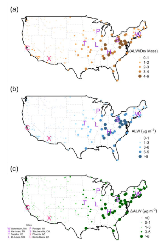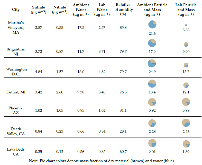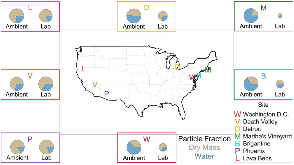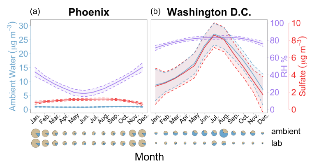|
Organic aerosol formation from the reactive uptake of isoprene epoxydiols (IEPOX) onto non-acidified inorganic seeds
|
journal
|
January 2014 |
|
Global Perspective on the Oxidative Potential of Airborne Particulate Matter: A Synthesis of Research Findings
|
journal
|
June 2014 |
|
Liquid Water: Ubiquitous Contributor to Aerosol Mass
|
journal
|
June 2016 |
|
Particle partitioning potential of organic compounds is highest in the Eastern US and driven by anthropogenic water
|
journal
|
January 2013 |
|
North American Regional Reanalysis
|
journal
|
March 2006 |
|
Gene Expression Profiling in Human Lung Cells Exposed to Isoprene-Derived Secondary Organic Aerosol
|
journal
|
July 2017 |
|
Role of Aerosol Liquid Water in Secondary Organic Aerosol Formation from Volatile Organic Compounds
|
journal
|
January 2017 |
|
Comments on the Updated Harvard Six Cities Study
|
journal
|
September 2006 |
|
PM 2.5 water-soluble elements in the southeastern United States: automated analytical method development, spatiotemporal distributions, source apportionment, and implications for heath studies
|
journal
|
January 2015 |
|
Assessing Meteorological Variable and Process Relationships to Modeled PM2.5 Ammonium Nitrate and Ammonium Sulfate in the Central United States
|
journal
|
September 2008 |
|
Additional Benefits of Federal Air-Quality Rules: Model Estimates of Controllable Biogenic Secondary Organic Aerosol
|
journal
|
July 2018 |
|
Estimating the National Public Health Burden Associated with Exposure to Ambient PM2.5 and Ozone: U.S. Public Health Burden of PM2.5 and Ozone
|
journal
|
May 2011 |
|
The Health Impact of Common Inorganic Components of Fine Particulate Matter (PM 2.5 ) in Ambient Air: A Critical Review
|
journal
|
January 2007 |
|
Daily mortality and air pollution in Santa Clara County, California: 1989-1996.
|
journal
|
August 1999 |
|
The Aerosol Research and Inhalation Epidemiology Study (ARIES): PM 25 Mass and Aerosol Component Concentrations and Sampler Intercomparisons
|
journal
|
August 2000 |
|
An Association between Air Pollution and Mortality in Six U.S. Cities
|
journal
|
December 1993 |
|
Aerosol Optical Thickness: Organic Composition, Associated Particle Water, and Aloft Extinction
|
journal
|
January 2019 |
|
The relative importance of soluble aerosols to spatial and seasonal trends of impaired visibility in the United States
|
journal
|
March 1994 |
|
Temporalization of Peak Electric Generation Particulate Matter Emissions during High Energy Demand Days
|
journal
|
March 2015 |
|
Organic Aerosols Associated with the Generation of Reactive Oxygen Species (ROS) by Water-Soluble PM 2.5
|
journal
|
March 2015 |
|
Health effects of acid aerosols on North American children: respiratory symptoms.
|
journal
|
May 1996 |
|
Human health effects of air pollution
|
journal
|
January 2008 |
|
An Exploratory Analysis of the Relationship Between Mortality and the Chemical Composition of Airborne Particulate Matter
|
journal
|
January 2000 |
|
A single parameter representation of hygroscopic growth and cloud condensation nucleus activity
|
journal
|
January 2007 |
|
Investigation of organic aerosol sampling artifacts in the los angeles basin
|
journal
|
November 1994 |
|
Evidence of aqueous secondary organic aerosol formation from biogenic emissions in the North American Sonoran Desert: AQUEOUS SOA FORMATION IN SONORAN DESERT
|
journal
|
July 2013 |
|
Global estimates of mortality associated with long-term exposure to outdoor fine particulate matter
|
journal
|
September 2018 |
|
Personal exposures to PM2.5 mass and trace elements in Baltimore, MD, USA
|
journal
|
December 2001 |
|
Associations between air pollution and mortality in Phoenix, 1995-1997.
|
journal
|
April 2000 |
|
Associations between Short-Term Changes in Nitrogen Dioxide and Mortality in Canadian Cities
|
journal
|
May 2004 |
|
A multiple-system, multi-channel diffusion denuder sampler for the determination of fine-particulate organic material in the atmosphere
|
journal
|
June 1993 |
|
Hygroscopicity of Water-Soluble Organic Compounds in Atmospheric Aerosols: Amino Acids and Biomass Burning Derived Organic Species
|
journal
|
March 2005 |
|
Evidence of Health Impacts of Sulfate-and Nitrate-Containing Particles in Ambient Air
|
journal
|
January 2007 |
|
High Electricity Demand in the Northeast U.S.: PJM Reliability Network and Peaking Unit Impacts on Air Quality
|
journal
|
July 2016 |
|
Health effects of acid aerosols on North American children: pulmonary function.
|
journal
|
May 1996 |
|
Effect of secondary organic aerosol from isoprene-derived hydroxyhydroperoxides on the expression of oxidative stress response genes in human bronchial epithelial cells
|
journal
|
January 2018 |
|
Reconciling satellite aerosol optical thickness and surface fine particle mass through aerosol liquid water: ALW AND AOT
|
journal
|
November 2016 |
|
Synthesis of the Southeast Atmosphere Studies: Investigating Fundamental Atmospheric Chemistry Questions
|
journal
|
March 2018 |
|
Highly Acidic Ambient Particles, Soluble Metals, and Oxidative Potential: A Link between Sulfate and Aerosol Toxicity
|
journal
|
February 2017 |
|
Drying-Induced Evaporation of Secondary Organic Aerosol during Summer
|
journal
|
March 2016 |
|
Wintertime spatial distribution of ammonia and its emission sources in the Great Salt Lake region
|
journal
|
January 2019 |
|
Spatial and seasonal variations of fine particle water-soluble organic carbon (WSOC) over the southeastern United States: implications for secondary organic aerosol formation
|
journal
|
January 2012 |
|
The effects of isoprene and NO x on secondary organic aerosols formed through reversible and irreversible uptake to aerosol water
|
journal
|
January 2018 |
|
Federal Reference and Equivalent Methods for Measuring Fine Particulate Matter
|
journal
|
January 2001 |
|
Ambient aerosol sampling using the Aerodyne Aerosol Mass Spectrometer
|
journal
|
January 2003 |
|
ISORROPIA II: a computationally efficient thermodynamic equilibrium model for K<sup>+</sup>–Ca<sup>2+</sup>–Mg<sup>2+</sup>–NH<sub>4</sub><sup>+</sup>–Na<sup>+</sup>–SO<sub>4</sub><sup>2−</sup>–NO<sub>3</sub><sup>−</sup>–Cl<sup>−</sup>–H<sub>2</sub>O aerosols
|
journal
|
January 2007 |
|
Ambient Air Pollutant Measurement Error: Characterization and Impacts in a Time-Series Epidemiologic Study in Atlanta
|
journal
|
October 2010 |
|
Decadal Changes in Seasonal Variation of Atmospheric Haze over the Eastern United States: Connections with Anthropogenic Emissions and Implications for Aerosol Composition
|
journal
|
June 2018 |
|
Decreasing Aerosol Water Is Consistent with OC Trends in the Southeast U.S.
|
journal
|
June 2015 |
|
A single parameter representation of hygroscopic growth and cloud condensation nucleus activity
|
journal
|
January 2006 |



